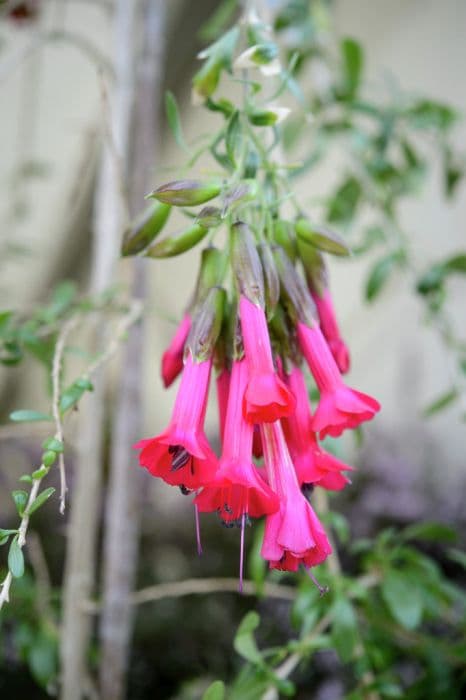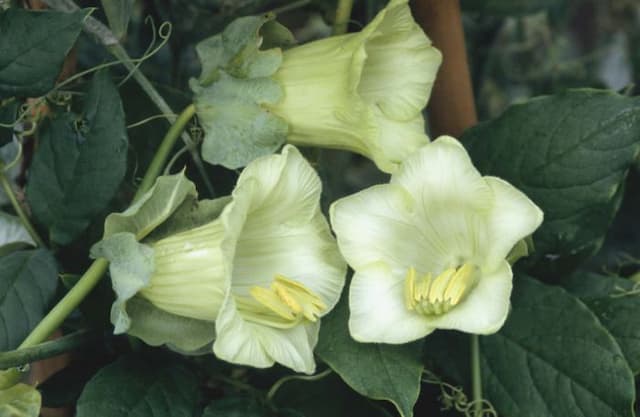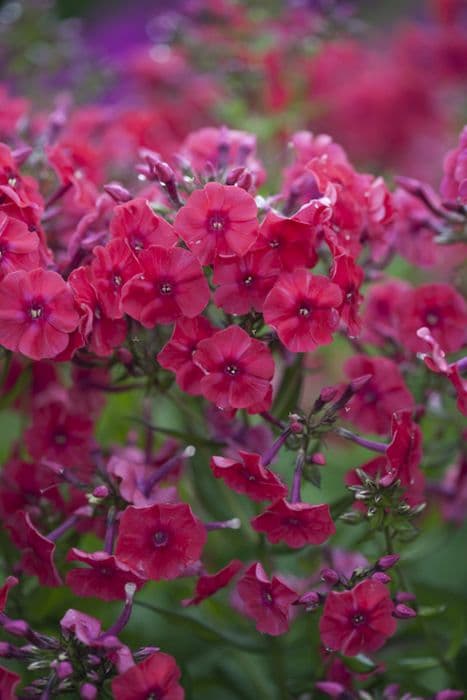Wild Blue Phlox Phlox divaricata 'May Breeze'

ABOUT
The Wild Sweet William 'May Breeze' is an herbaceous perennial that ushers in a light, airy appearance in the garden with its clusters of delicate, star-shaped flowers. These blooms showcase a soft, pale blue to lavender color and possess a delightful fragrance that's particularly noticeable in the evenings and early morning. The individual flowers are small, but en masse, they create a stunning effect. The leaves of this plant are lance-shaped and can vary in shades of green. They provide a verdant backdrop to the blooms and are sometimes slightly hairy to the touch. The stems are slender and can have a slightly sprawling habit, interweaving with neighboring plants in a naturalistic setting. They add charm to woodland gardens or informal borders where their distinct flower color and fragrance can be appreciated up close. The overall form of Wild Sweet William 'May Breeze' is loose and natural, with its stems and leaves creating a sense of movement, as if swaying with a gentle spring breeze. Its blooms tend to appear in the later part of spring and can last into early summer, offering a delightful display when many other garden favorites are just beginning to wake up from their winter slumber. This plant is ideal for gardeners who appreciate a wild, cottage garden style and are looking for something to brighten up shaded areas with its soft, welcoming hues.
About this plant
 Names
NamesSynonyms
Wild Blue Phlox, Wild Sweet William, Woodland Phlox, Louisiana Phlox
Common names
Phlox divaricata 'May Breeze'
 Toxicity
ToxicityTo humans
Woodland phlox is not commonly known to be toxic to humans. Generally, it is considered safe and non-poisonous. However, like with any plant, individual allergies or sensitivities can occur, so it is always best to avoid ingesting plants that are not commonly used as food, as they can cause gastrointestinal discomfort or other allergic reactions in sensitive individuals.
To pets
Woodland phlox is not commonly known to be toxic to pets. It is generally considered non-toxic to dogs, cats, and other domestic animals. While it is not expected to cause serious harm if ingested, it is still advisable to prevent pets from eating ornamental plants as they can potentially cause mild stomach upset or an allergic reaction in some animals.
 Characteristics
CharacteristicsLife cycle
Perennials
Foliage type
Deciduous
Color of leaves
Green
Flower color
Pale blue
Height
1 foot (0.30 meters)
Spread
1 foot 6 inches (0.46 meters)
Plant type
Herb
Hardiness zones
3-8
Native area
North America
Benefits
 General Benefits
General Benefits- Attracts Pollinators: Phlox divaricata 'May Breeze', commonly known as Woodland Phlox, invites bees, butterflies, and other beneficial insects, sustaining local ecosystems.
- Easy to Grow: Woodland Phlox is known for being a low-maintenance plant suitable for a variety of garden conditions.
- Spring Bloomer: It produces clusters of fragrant flowers in spring, adding seasonal beauty to the garden.
- Shade Tolerant: Thrives in partial to full shade, making it ideal for wooded gardens or shady spots where other plants might struggle.
- Drought Resistant: Once established, Woodland Phlox is relatively drought-tolerant, requiring minimal watering.
- Ground Cover: Its spreading habit makes it useful for ground cover, controlling weeds, and preventing soil erosion.
- Naturalizes Easily: This plant can spread and form colonies, creating a natural, wildflower garden aesthetic.
- Deer Resistant: Woodland Phlox is typically resistant to deer, reducing the likelihood of damage by wildlife.
- Aesthetic Appeal: Offers variety with its pale blue to lavender flowers, enhancing the visual appeal of garden spaces.
 Medical Properties
Medical PropertiesThis plant is not used for medical purposes.
 Air-purifying Qualities
Air-purifying QualitiesThis plant is not specifically known for air purifying qualities.
 Other Uses
Other Uses- Culinary accent: The flowers of Woodland Phlox can be used as a decorative, edible accent on salads or desserts for a touch of color and a mild floral flavor.
- Natural dye: The blossoms can be used to create a natural dye for fabrics, providing a soft purple to blue hue.
- Photography backdrop: With its attractive clusters of flowers, Woodland Phlox makes an excellent backdrop for nature photography.
- Butterfly garden: Including Woodland Phlox in gardens can attract butterflies, adding to the biodiversity and aesthetic of the space.
- Thematic gardening: Woodland Phlox can be utilized in moon gardens due to its light-colored flowers that can reflect moonlight at night.
- Scented sachets: Dried flowers of the Woodland Phlox can be placed in sachets to provide a gentle, floral fragrance to drawers or closets.
- Artistic inspiration: The soft pastel shades of the flowers can be an inspiration for artists and can be used as a reference for paintings or other artwork.
- Fairy gardens: Small and delicate, Woodland Phlox is an ideal plant for creating whimsical fairy gardens.
- Education: Can be used in educational settings to teach about native plants and the importance of planting species that support local ecosystems.
- Ecosystem support: Planting Woodland Phlox can provide ground cover in forested areas, helping to prevent soil erosion and maintaining soil health.
Interesting Facts
 Feng Shui
Feng ShuiWoodland phlox is not used in Feng Shui practice.
 Zodiac Sign Compitability
Zodiac Sign CompitabilityWoodland phlox is not used in astrology practice.
 Plant Symbolism
Plant Symbolism- Harmony: Woodland phlox often symbolizes harmony, as it coexists peacefully with other plants in its native woodland environments.
- Union: The clusters of flowers can represent the coming together of many parts to make a whole, symbolizing unity and togetherness.
- Sweet Dreams: With its gentle appearance and sweet fragrance, woodland phlox is sometimes associated with sweet dreams and comfort.
- Proposal: In the language of flowers, phlox can symbolize a proposal or an offer of marriage, often denoting love and partnership.
- Agreement: The name "phlox" is derived from the Greek word for "flame" or "flower," but it has also come to represent harmony and agreement between people.
 Water
WaterWoodland phlox, commonly known as wild blue phlox or wild sweet william, prefers consistently moist but well-drained soil. During the first growing season, it’s vital to establish a good root system, so water the plants deeply once a week, providing about 1 to 1.5 inches of water each time. After establishment, they are relatively drought tolerant but perform best with regular watering, especially during prolonged dry spells. Recommended watering frequency is once every week or two, ensuring that the soil does not dry out completely. Be cautious not to overwater, as this can lead to root rot—aim for about one gallon per plant every week in the absence of rainfall.
 Light
LightWild blue phlox thrives best in partial shade, although it can tolerate full shade. It is ideal for planting under deciduous trees where it will receive dappled sunlight throughout the day, which closely mimics its natural woodland habitat. Avoid placing it in full, intense sun, especially in hotter climates, as this can stress the plant and cause the foliage to burn.
 Temperature
TemperatureWild blue phlox is hardy and can endure a range of temperatures, but it grows best in an environment where the temperature ranges between 60 to 75 degrees Fahrenheit. It can survive minimum winter temperatures down to -20 degrees Fahrenheit and maximum summer temperatures as long as they aren’t prolonged and extreme. Ensure that the roots are well-mulched to protect against extreme temperatures.
 Pruning
PruningWild blue phlox benefits from pruning to encourage bushier growth, improve air circulation, and induce a second bloom. Pinch back the tips of stems in the spring to promote branching. After the initial blooming period, cutting back the flower stems to about 1 to 2 inches above the foliage can stimulate a second bloom. Pruning is best done immediately after the first flush of flowers fade, typically in late spring or early summer.
 Cleaning
CleaningAs needed
 Soil
SoilWoodland Phlox thrives in organically rich, moist, well-drained soil with a pH range of 6.0 to 8.0. A good mix would be equal parts garden soil, compost, and peat moss to ensure fertility and drainage.
 Repotting
RepottingWoodland Phlox generally does not require frequent repotting and can be done every 2-3 years or when it visibly outgrows its current container.
 Humidity & Misting
Humidity & MistingWoodland Phlox prefers moderate humidity levels; it can tolerate the natural humidity found in most outdoor environments without needing any special attention.
 Suitable locations
Suitable locationsIndoor
Ensure bright indirect light and consistent moisture.
Outdoor
Plant in dappled shade and moist, rich soil.
Hardiness zone
3-9 USDA
 Life cycle
Life cycleThe life cycle of Phlox divaricata 'May Breeze', commonly known as Wild Blue Phlox or Woodland Phlox, begins with germination, which occurs in a moist environment when temperatures are mild in spring. Following germination, the seedlings grow into juvenile plants with a rosette of leaves near the soil level. As they mature, the plants develop a series of stems that bear elongated leaves and become bushier through vegetative growth. The iconic fragrant flowers blossom in spring to early summer, showcasing pale blue to violet petals that attract various pollinators. After pollination, the plant produces small seed capsules, which when mature, release seeds to the environment for dispersal. During winter, Phlox divaricata 'May Breeze' enters a period of dormancy, with the above-ground parts dying back and the plant surviving underground through its root system until the next growing season.
 Propogation
PropogationPropogation time
Spring to summer
The Phlox divaricata 'May Breeze', commonly known as Woodland phlox or Wild Sweet William, is typically propagated by division. This method is favored as it is straightforward and usually very successful. The best time to propagate by division is in early spring or fall when the plant is not in full bloom. To propagate by division, carefully dig up the plant, ensuring a good amount of roots are attached to each section. Gently tease apart the clumps into smaller clumps, each with several shoots and a healthy root system. Replant the divided sections at the same depth they were growing at originally, spacing them about 12 to 15 inches (30 to 38 cm) apart to allow for growth. Water the newly planted sections well to help establish them in their new locations.









